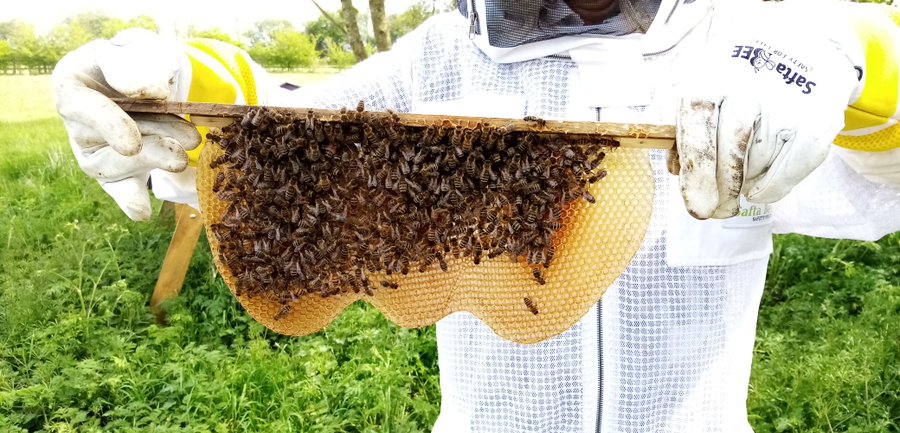Honey Bee
Beekeeping Gloves: A Comprehensive Guide
Beekeeping Gloves: A Comprehensive Guide

Beekeeping is a fascinating and rewarding hobby. However, it can also be dangerous if proper safety measures are not taken.
Beekeeping gloves are a crucial piece of equipment for any beekeeper, as they protect the hands from stings and provide better grip when handling the bees and the hive.
In this article, we will discuss everything you need to know about beekeeping gloves, including their types, materials, sizes, and maintenance.
Importance of Beekeeping Gloves
Beekeeping gloves are essential for any beekeeper to protect their hands from bee stings. Bee stings can cause pain, swelling, and in rare cases, severe allergic reactions that can be life-threatening.
Beekeeping gloves also provide better grip and control when handling the bees and the hive, reducing the risk of dropping or damaging them.
They also protect the bees from any harmful chemicals or oils on the hands, which can harm the bees and disrupt their colony.
Types of Beekeeping Gloves
There are several types of beekeeping gloves available in the market, each with its own advantages and disadvantages. Let's take a look at some of the most common types of beekeeping gloves.
Disposable Gloves
Disposable gloves are made of thin material, usually latex or nitrile, and are designed for single-use only. They are cheap and convenient, but not very durable or protective. Disposable gloves are ideal for beginners or occasional beekeepers who do not want to invest in expensive gloves.
Leather Gloves
Leather gloves are the most popular and traditional type of beekeeping gloves. They are made of durable and thick leather that provides excellent protection against bee stings.
Leather gloves are also comfortable to wear and have good grip and control. However, they can be heavy and hot, especially in warm weather.
Nitrile Gloves
Nitrile gloves are a newer type of beekeeping gloves that are gaining popularity due to their superior durability and protection.
Nitrile gloves are made of synthetic rubber that is resistant to punctures, cuts, and chemicals. They are also lightweight and breathable, making them ideal for warm weather. However, nitrile gloves can be more expensive than other types of gloves.
Ventilated Gloves
Ventilated gloves are designed to provide both protection and comfort in hot weather. They are made of breathable materials such as mesh or perforated leather that allow air to circulate and keep the hands cool. Ventilated gloves are ideal for beekeepers who work in hot and humid conditions.
Observation Gloves
Observation gloves are a unique type of beekeeping gloves that allow beekeepers to inspect the bees and the hive without disturbing them.
They are made of thin and transparent material, usually latex or nitrile, that provides good visibility and sensitivity. Observation gloves are ideal for beekeepers who want to monitor the bees without wearing full protective gear.
Choosing the Right Size of Beekeeping Gloves
Choosing the right size of beekeeping gloves is crucial for comfort and protection. Gloves that are too small can be uncomfortable and restrict movement, while gloves that are too big can be loose and prone to slipping.
To determine the right size of beekeeping gloves, measure the circumference of your hand at the widest point, excluding the thumb. Then, compare the measurement to the size chart of the glove manufacturer to find the appropriate size.
Maintaining Beekeeping Gloves
Maintaining beekeeping gloves is essential to ensure their longevity and effectiveness. Here are some tips for cleaning, storing, and replacing beekeeping gloves.
Cleaning
Beekeeping gloves should be cleaned regularly to remove any dirt, grime, or debris that may compromise their protective properties.
To clean leather gloves, wipe them with a damp cloth and mild soap. Do not soak or machine wash leather gloves, as this can damage the leather. To clean nitrile or rubber gloves, wash them with warm water and mild detergent. Rinse thoroughly and hang to dry.
Storage
Beekeeping gloves should be stored in a cool and dry place, away from direct sunlight and heat sources. They should be stored flat or hanging, rather than folded or crumpled, to prevent creases and cracks in the material.
Gloves should also be stored separately from other beekeeping equipment, such as hive tools and suits, to prevent contamination.
Replacement
Beekeeping gloves should be replaced periodically, depending on their frequency of use and wear and tear. Leather gloves may last for several years with proper care, while disposable gloves should be replaced after each use.
Inspect gloves regularly for signs of wear and tear, such as holes, cracks, or punctures, and replace them if necessary.
Conclusion
Beekeeping gloves are an essential piece of equipment for any beekeeper. They protect the hands from bee stings and provide better grip and control when handling the bees and the hive.
There are several types of beekeeping gloves available, each with its own advantages and disadvantages. Choosing the right size and material of beekeeping gloves is crucial for comfort and protection.
Regular maintenance, such as cleaning, storing, and replacing, is also essential to ensure their longevity and effectiveness.
